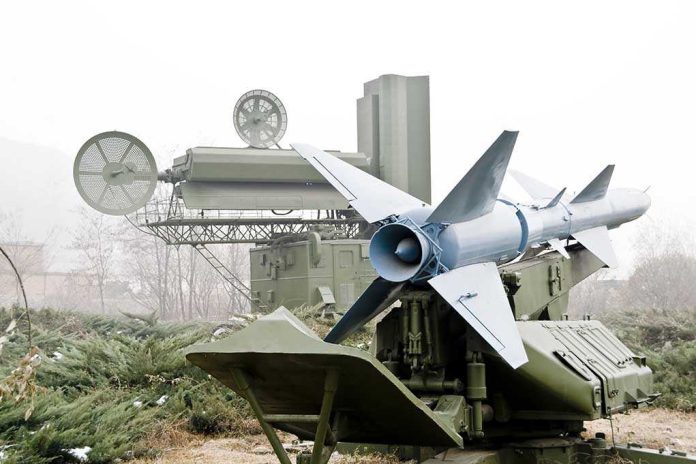
Russia’s new Oreshnik hypersonic missile, now in mass production, poses a direct threat to American soil with its 3,425-mile range and claimed ability to evade all Western defense systems.
Key Takeaways
- Russia has begun mass production of the Oreshnik hypersonic missile, capable of Mach 10 speeds and ranges up to 3,425 miles, putting Europe and western United States within strike range
- The missile can carry either nuclear or conventional warheads and was first deployed in combat against Ukraine in November 2024
- President Putin claims the weapon is “impossible to intercept” by any US-made defense system, though Western officials have downplayed this assertion
- The missile’s deployment on mobile launchers and potential positioning in Belarus by 2025 significantly raises security concerns for NATO’s eastern flank
- The weapon’s development follows the collapse of the Intermediate-Range Nuclear Forces Treaty, potentially triggering a new arms race
Putin’s New Strategic Weapon Enters Production
Russia has officially begun full-scale production of its Oreshnik hypersonic missile system, a development that substantially alters the strategic balance of power in Europe and beyond. The solid-fuel, mobile-launched intermediate-range ballistic missile represents Russia’s most advanced military technology, capable of traveling at Mach 10 speeds while carrying multiple independently targetable reentry vehicles for both nuclear and conventional payloads. President Putin made the announcement following the missile’s combat debut against Ukraine, emphasizing Russia’s determination to strengthen its military deterrence against what it perceives as Western aggression.
“Serial production of the latest Oreshnik medium-range missile system is under way,” said Vladimir Putin, Russian President,
The Oreshnik, derived from the RS-26 Rubezh platform with elements from the Bulava missile, represents a significant technological achievement for Russia’s defense industry despite Western sanctions designed to cripple such advancements. With its extraordinary range capability of up to 3,425 miles, the missile can theoretically strike targets throughout Europe and portions of the western United States. This development comes at a critical juncture as Russian forces face stalled advancements in Ukraine and continuing international condemnation for civilian casualties caused by aerial attacks.
Combat Debut and Strategic Implications
The Oreshnik missile first saw operational use in November 2024, when Russia launched it against a defense facility in Dnipro, Ukraine. According to Russian officials, this strike was a retaliatory measure against what they claimed were Western-backed attacks on Russian territory. The missile’s deployment marked a significant escalation in the conflict, demonstrating Russia’s willingness to employ advanced weapons systems against Ukrainian infrastructure. NATO spokesperson Farah Dakhlallah characterized the strike as simply “another example of Russia’s attacks on Ukrainian cities,” reflecting the alliance’s effort to downplay the technological significance.
“Putin has also repeatedly underscored the strategic potency of the system, stating that the Oreshnik’s destructive force is “comparable to a nuclear weapon” and that its speed and maneuverability make it “impossible to intercept”. A claim that, while questioned by some Western analysts, is difficult to fully disprove without access to classified intercept data,” said Vladimir Putin, Russian President,
The missile’s launch platform, the Belarus-made MZKT-7930 “Astrolog” transporter-erector-launcher, provides high mobility and quick deployment capabilities, making it particularly difficult to track and target. Intelligence reports suggest Russia may deploy the Oreshnik to Belarus by 2025, a move that would significantly increase security concerns for NATO’s eastern flank countries, particularly Poland and the Baltic states. This potential deployment near NATO borders would dramatically reduce warning times for any potential strikes against European targets.
Global Security Implications and Western Response
The Oreshnik’s introduction comes in the wake of the collapsed Intermediate Range Nuclear Forces (INF) Treaty, which previously prohibited such weapons development. Russia’s decision to mass-produce this hypersonic missile has complicated NATO’s strategic planning and may prompt increased Western investment in counter-hypersonic capabilities. US officials have attempted to downplay the missile’s significance, suggesting Russia currently possesses limited quantities, but the commencement of mass production directly challenges this narrative and signals Russia’s long-term commitment to this weapons system.
“We are interested in Iran’s cooperation with the IAEA continuing,” said Sergei Lavrov, Russian Foreign Minister,
The timing of the announcement also coincides with Russia’s diplomatic efforts regarding Iran’s nuclear program, with Foreign Minister Sergei Lavrov urging continued cooperation with the International Atomic Energy Agency. This dual approach of military advancement and diplomatic engagement suggests Russia is pursuing a comprehensive strategy to enhance its global influence while challenging Western security structures. President Trump’s administration now faces significant pressure to develop an effective response to this emerging threat without triggering a new arms race that could further destabilize international security.














